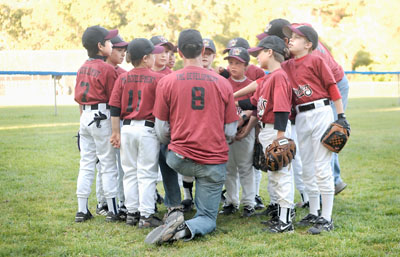 Each month for Marin Magazine, I make a photo and write a short essay (200 words) that fills a page in the front of the book. Here’s an example about Life on the Edge, and another about being Between Sea and Sky.
Each month for Marin Magazine, I make a photo and write a short essay (200 words) that fills a page in the front of the book. Here’s an example about Life on the Edge, and another about being Between Sea and Sky.
For June, the editor wanted something about Father’s Day, a cliche idea, but I liked the challenge of creating something that wasn’t a cliche and thought I might find it at a local Little League game.
I spent a couple of hours at one game and made some fine actions shots, but couldn’t capture the moment I wanted between a coach and a player or a father and a son. I was looking for that instant, communicated visually, when knowledge moves from one generation to the next.
I returned a week later, this time to a night game and spent about an hour shooting before the game as the kids and dads warmed up, playing catch and a bit of pepper. As the light faded, I looked for some final shots. It would soon be too dark to shoot the game. Suddenly, the coach called all the boys near and he knelt before them. I has to change lenses and got off two frames before the huddle broke. The above frame image ran in the magazine.
Below is the essay I wrote to accompany the picture.
—————————————–
… And They Will Come
“Little League baseball is a good thing ‘cause it keeps the parents off the streets and it keeps the kids out of the house.” — Yogi Berra
